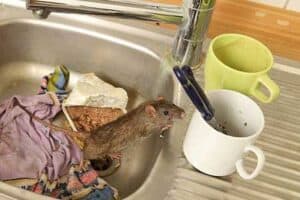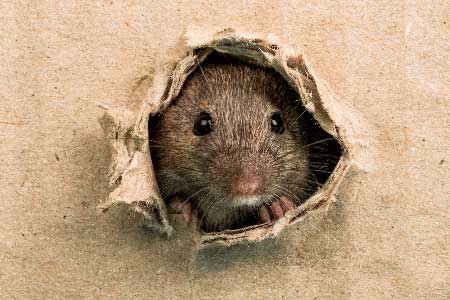Seeing a rat in your home can be a terrifying experience. Rodents are some of the most unwelcome visitors to any household because they can spread disease and cause lasting damage to your property. If you find yourself in this position, you have one option: figure out how to kill rats or move out.
Let’s explain how rats get into your home, the damage they can do and teach you how to kill rats with the only five effective methods that work in New York State.
How rats get into your home
Before we show you how to kill rats, it’s worth explaining how they manage to get into your home in the first place.
Rats and mice are both social creatures. While you don’t want either species in your home, rats are particularly alarming. Some of the best methods to kill mice work, but not all of them are transferable to your rat problem. They are bigger, brighter and more destructive than mice. As a result, you need to get rid of rats before they get comfortable.
One interesting thing to note is that rats are pretty shy. They’d rather stay out of sight of humans. So once you start noticing them, it’s a sure sign that you’ve got a problem on your hands.
Rats are very sociable with their kind. They live in large families that grow at an astonishing rate. For example, a single breeding pair can produce up to 1,000 rats a year. If you see one rat, there’s most likely more around, which underlines the importance of learning to kill rats before they breed.
As we said, rats typically prefer to live out of sight. They’re cautious enough creatures who like to operate away from the dangers humans pose. Sometimes, however, they do enter homes.
Rats come to your home because of internal or external circumstances.
Internal Rat Population Factors:
Rats live in places that give them access to food and water. They seek out environments that are safe places to breed their families. Even if your home is clean, rats have an accessible source of food and shelter, so they’re likely to stick around.
External Rat Population Factors:
One of the more likely reasons for a rat invasion is that their existing colony has been disturbed. Building work or basement excavations can disrupt a rat’s habitat, forcing them to flee to a new home. Similarly, flooded or blocked drains or sewers can push rats out of these spaces and into your home.
Finally, rats often live in abandoned or derelict buildings. If their population grows too big, they might need to leave their home in search of food.
What damage can rats do to your home?

Rats can scale any surface. They have sharp teeth that can chew through walls and cables, causing structural and electrical damage. On top of that, they spread diseases.
If rats have made it into the fabric of your building, it’s a significant cause for concern. Rat’s teeth never stop growing. As a result, they are constantly gnawing away at items to maintain their dental health. Rats will chew at wood and cables, leave droppings and urine everywhere, and can even spread Weill’s disease.
In short, rats are super destructive; if you find any, you need to act. You must know how to kill rats to protect your family and home.
Here are 5 of the best methods for how to kill rats
#1 Way How To Kill Rats – Trapping
Trapping is one of the most common and cost-effective methods for killing rats. There are a relatively wide variety of traps available on the market. Some of the most popular traps are:
Mechanical traps: Mechanical traps are pest removal devices that most people will be familiar with. They are made from wood or plastic and have a hinge that pulls back, triggered when a rat runs over them. Often, people choose to leave some cheese or food on the trap to attract the rodent.
Live traps: Live traps have become a popular product over recent years. These traps capture the rat inside a box alive, so you can then release them far away from your home or your nest.
The best method with traps is to leave many of them around the areas that rats travel in. Set them tight against walls where you have noticed the rats and sit back and wait.
While traps are a fairly standard way to get rid of rats, they have some drawbacks. Many people don’t want to see a rat after it’s been trapped. Secondly, if you have pets or small children in the house, they can end up hurting themselves by triggering the trap.
#2. Glue boards
Rat glue boards are a sheet of material with an adhesive that immediately traps rats as they walk over them. Glue boards are a good option for rats too intelligent to fall for your traps or take your bait.
Some of the advantages of glue boards are that they are:
- non-toxic
- cheap
- easy to use
Additionally, they come in lots of different sizes.
Rats are creatures of habit. They typically like to use the same route to and from their nests. You can use the rat’s lack of curiosity against them by placing glue boards in the areas you have seen them travel. The proper placement is the key to successfully using glue boards like any other trap.
Rats generally move along internal walls and hallways. They can also move through cupboards. Best practice dictates placing the traps flush to the wall but away from corners. Try to put them in the area where you’ve seen the rats.
Remember, rats are cautious creatures. It might take them a few days to travel over the glue board. If you haven’t caught anything after a day or two, it’s time to move the trap to a new location.
#3. Baiting
Rodenticides are a type of pesticide designed to kill rats and mice. These rat poisons usually come in little balls of different strengths. Some require one dose to kill a rat, while others require multiple quantities to build up to lethal toxicity levels.
You can split rat poison into two categories: anticoagulants and non-anticoagulants
Anticoagulants: Work by halting the ability of the rodent’s blood to clot. When they consume this poison, they are killed by internal bleeding.
Non-anticoagulants: Work by interfering with the rat’s nervous system or calcium levels.
Depending on your situation, you can leave the bait along the walls. Also, be sure to target areas where rats have been. It’s essential to cut off all other food sources for the rats if you want them to take the bait.
One drawback of rodenticides is that small children or animals might eat the bait. As a result, many people choose to use rat bait stations. These stations are little standalone boxes filled with bait. They contain little holes that rats can squeeze into but are too small for kids and pets to get at the bait.
You should avoid moving it around if you set a rat bait station. As mentioned earlier, rats are very cautious and aware of what is in their environment. In effect, you want them to become used to the bait station and think it is normal. Then they will be far more likely to enter it and eat the poison.
Baiting Conclusion:
Finally, there is a common and persistent myth that rats go outside to die once they’ve eaten poison. It’s hard to know how this myth started, but it’s generally not true. What is far more likely to happen is that if a rat feels unwell, it will return to its nest and die.
The smell of dead rats is far from pleasant. This fact isn’t great news for homeowners. A rat’s nest could be anywhere in your house and may require cutting a hole in the wall to locate it.
So while baiting is maybe the easiest method to implement, the clean-up can be far more complex and involve ripping up walls to remove the stench of dead rodents in your house.
#4. Tracking Powders
Tracking powders work similarly to baiting, but instead of relying on the rat eating the bait, it spreads a powder on their feet and fur, which they ingest during their daily grooming rituals.
These pesticides are very deadly and can cause issues to humans and animals. To safely use tracking powders for rats, they should be laid in areas where humans won’t frequent. Tracking powders are an excellent choice when rats don’t eat the bait. They are generally restricted, however, and can only be purchased by Professional Pest Control Rat Exterminators in New York.
Tracking powders are incredibly effective. If you want to know how to kill rats in the easiest way possible, this is probably it. So, now you’re probably thinking, why isn’t tracking powder used for every job?
Well, the thing is that when it is misused, tracking powder can pose a particular toxic risk for humans. For example, if you lay tracking powder in a high-traffic area for rats, they will be covered by the powder and potentially spread it around. This scenario means it could wind up on food or other surfaces.
Considering all this, a skilled and knowledgeable professional should only apply tracking powder. Rat tracking powder should never be used near ventilation systems or in drafty locations. The danger here is that the particles could become airborne and spread onto surfaces or food and cause damage to humans.
#5. Exclusion From Property / Structural Changes

While killing individual rats can significantly reduce the rat population, it is typically a short-term fix. To protect your house from rats, you need to shore up the areas where they enter or move around your property.
Many homes, especially older ones, are full of cracks and crevices that rats can use to move around. One problem is that rats can fit through a ½-inch entry point. For context, that’s about the diameter of your thumb.
Materials For Excluding Rats:
Two of the best materials you can use to seal up these entry points are:
Copper wool mesh: A copper wool mesh is malleable enough that you can stuff it into cracks to deny rats entry to your home but durable enough that they can’t chew through it.
Foam: Gun foam is another way to seal up cracks and spaces that rats can get through. Once you’ve directed it at a surface, it expands and dries into a hard material that rats can eat through.
Going down this route, you need to be incredibly thorough. If you only seal up a small proportion of the holes, rats will find other areas.
In your indoor areas, you need to:
- Examine the interior and exterior walls and plug any gaps with wool or foam
- Close openings that are ½ inch or more, including around windows and doors
- Eliminate gaps under garage doors with rubber, vinyl, or bristle sweep
- Seal vents, drains, pipes, etc.
- Remove sources of food and water
Additionally, depending on which type of rat population you have, you may need to seal your roof and fix any loose roof shingle to stop rats from entering from above. You’ll also need to seal your dumpster or garbage to stop attracting pests. Finally, look at any potential food or water sources, like bird or animal feeds, and secure them in tight-fitting containers.
So, now you know how to kill rats. These are the only five methods that work for killing rats in New York State. It’s important to remember, however, that rats are hard to get rid of and trying one of these methods isn’t guaranteed to work.
Hiring a professional rat exterminator will give you a far greater chance of success. They will have all the tools and expertise required to ensure your home is rid of this destructive rodent population.
If you have rats on your property, you need to act fast. They typically go unnoticed until their population grows. By then, they’re breeding in the insulation and become hard to eliminate.
We offer our customers a 100% satisfaction guarantee. This means we stand behind or work until the last rat is gone. Our rate extermination guarantees are always for long periods. By employing the best and most experienced exterminators, we can work with you to design a pest control strategy that gets results. So, if you’ve got a rat problem, call us today to discuss how we can resolve the issue.


